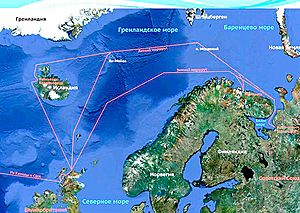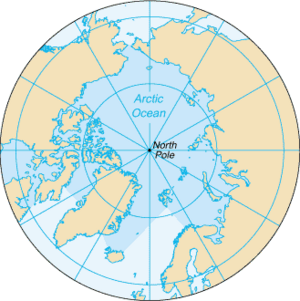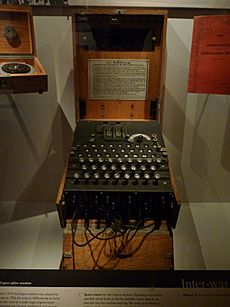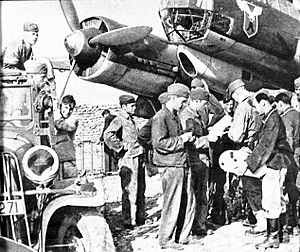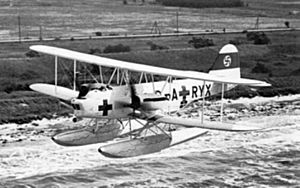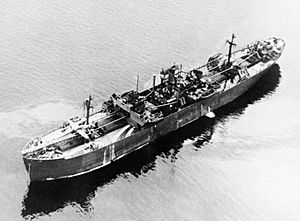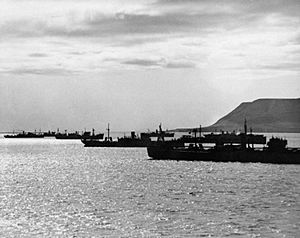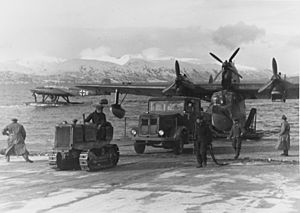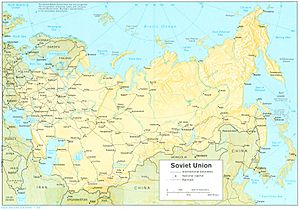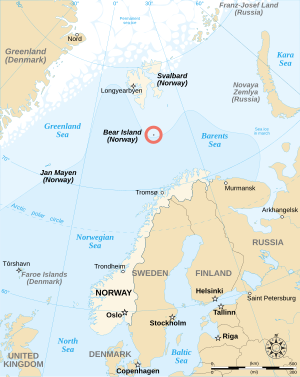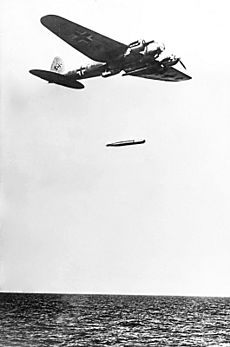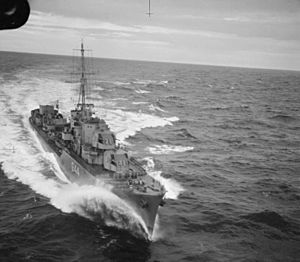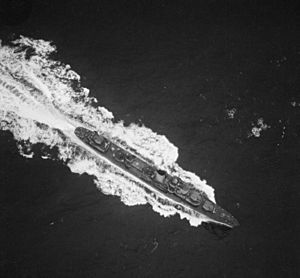Convoy PQ 16 facts for kids
Quick facts for kids Convoy PQ 16 |
|||||||
|---|---|---|---|---|---|---|---|
| Part of Arctic naval operations of the Second World War | |||||||
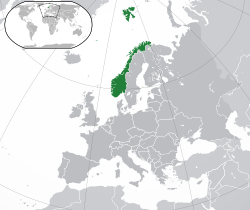 German-controlled Norway (in green) was a big threat to the sea route to northern Russia. |
|||||||
|
|||||||
| Belligerents | |||||||
| Allies | Germany | ||||||
| Commanders and leaders | |||||||
| Newell Gale (convoy) Richard Onslow (escorts) |
Alexander Holle Hans Roth Hermann Busch |
||||||
| Units involved | |||||||
| PQ 16 and escorts | Luftflotte 5 | ||||||
| Strength | |||||||
| 36 merchant ships varying number of escorts |
108 aircraft | ||||||
| Casualties and losses | |||||||
| 7 ships sunk 1 turned back |
3–6 aircraft shot down 1 damaged 2 U-boats damaged |
||||||
Convoy PQ 16 was a group of ships that sailed together for safety during World War II. From May 21 to May 30, 1942, British, American, and Allied ships traveled from Iceland to ports in the Soviet Union. This journey was part of the dangerous Arctic convoys. It was the biggest convoy of its kind so far, with many escort ships and submarines protecting it. Another convoy, QP 12, sailed back on the same day.
Germany's plan to quickly defeat the Soviet Union in Operation Barbarossa failed in 1941. Because of this, Germany started building up its forces in Norway. They wanted to stop the Arctic convoys using ships, planes, and submarines. The German air force in Norway, called Luftflotte 5, got more bombers and torpedo planes in early 1942. They changed their tactics to attack convoys as they sailed between the Norwegian coast and the Arctic ice.
During this time of year, the sun never set, making it hard for the ship crews to rest. The constant daylight and glare from the ice were very tiring. On May 25, German air attacks began. Bombers and torpedo planes worked together, launching torpedoes at the same time to make it harder for ships to dodge them. These air attacks continued until June 1. They sank six ships, and one more was lost to a German submarine (U-boat). The Allies shot down 3 to 6 German planes and damaged one. On May 27 alone, 108 air attacks were counted.
After the convoy, the escort commander suggested that future convoys needed much more anti-aircraft firepower. They also needed air cover from an escort carrier (a small aircraft carrier). The Germans claimed they had almost completely destroyed the convoy. They decided that air attacks were more effective than submarine attacks in the long daylight hours. The German tactic of combining dive-bombing and torpedo-bombing, dropping torpedoes all at once (called the "Golden Comb"), proved successful for them.
Contents
Background
Helping the Allies
After Germany invaded the USSR in June 1941, the UK and USSR agreed to help each other in the war. By September 1941, Britain had sent many supplies, including aircraft, rubber, boots, and metals. In October 1941, representatives from Britain, the US, and the USSR met in Moscow. They planned what supplies would be sent until June 1942.
The Soviet Union needed military equipment because their factories were moving. Britain and the US promised to send 400 aircraft and 500 tanks each month. They also sent raw materials, food, and medical supplies. The USSR didn't have enough ships to move these supplies. So, Britain and America agreed to deliver them.
The Arctic Ocean
The waters between Greenland and Norway are some of the stormiest in the world. They are often filled with snow, sleet, and hail. The sea temperature rarely goes above 4° Celsius (about 39° Fahrenheit). If a person fell into the water, they would likely die quickly without immediate rescue. The extreme cold caused spray to freeze on ships, making them top-heavy and dangerous.
Warm water from the Gulf Stream meets the cold Arctic water. This mix creates thick fog, which could hide convoys. However, it also made ASDIC (sonar) less effective for finding U-boats. In winter, the polar ice can extend far south, forcing ships closer to German air bases. In summer, the ice melts back, allowing ships to sail further out. The area has constant darkness in winter and constant daylight in summer. This made air reconnaissance either very difficult or very easy, depending on the season.
Arctic Convoys and Their Importance
In October 1941, British Prime Minister Winston Churchill promised to send a convoy to the USSR every ten days. These convoys would deliver tanks and aircraft. Ships from Britain and the US would gather in Iceland, a good meeting point. By late 1941, a system for convoys was set up. A "convoy commodore" led the merchant ships, making sure they sailed in a tight formation. This helped protect them.
In large convoys, the commodore worked with other officers to control the ships' speed and direction. In summer, convoys sailed far north, then south into the Barents Sea to Murmansk and Archangelsk. In winter, the ice forced them closer to Norway. Until March 1942, few merchant ships were lost. The main problems were the poor ports in the USSR. As summer approached, daylight increased, and convoys became larger.
German Intelligence
Code Breaking at Bletchley Park
The British code-breaking center at Bletchley Park was very important. By June 1941, they could quickly read messages from German naval ships and U-boats. In February 1942, U-boats in the Atlantic changed their codes, but those in Arctic waters still used older ones. By mid-1941, British listening stations could also read German air force messages. This gave early warnings of German air operations.
Later, British warships had RAF teams on board. These teams listened to German air force radio signals. They could often predict attacks about twenty minutes before radar detected them. This was a huge advantage for the convoys.
German Code Breaking
The German code-breaking service, called B-Dienst, also had success. By 1939, they had broken several British naval codes. This helped German ships avoid British forces and launch surprise attacks. From June to August 1940, they used this information to sink six British submarines. In 1941, they read signals that told U-boats where British convoys were.
In February 1942, B-Dienst broke another important British code. By March, they could read up to 80% of the messages. This continued until December 1943. Later, Finnish intelligence also decoded a Soviet message. This message revealed the convoy's planned route to the Germans.
Preparing for Battle
German Air Force in Norway
In March 1942, Adolf Hitler ordered a stronger effort against the convoys. He wanted to weaken the Soviet army and prevent Allied troops from reaching northern Russia. The German air force in Norway, Luftflotte 5, was strengthened. The German navy was also told to stop the Arctic convoys. The air force and navy were to work closely together.
Luftflotte 5 received more bombers and long-range patrol planes. It was divided into different commands. The largest command, Fliegerführer Nord (Ost), was based at Kirkenes. It was responsible for attacking Murmansk and Archangelsk, as well as convoys. Other commands were set up to detect convoys early and attack them.
German Air Tactics
When a convoy was spotted, German long-range planes would search for it. Once found, they would try to stay in contact, even in bad weather. If contact was lost, they would guess the convoy's path and search again. All German air commands worked together as the convoy moved through their areas. They were ordered to keep attacking the convoy until it reached its destination.
From late March to late May, German air attacks had little effect on previous convoys. Bad weather was often as dangerous as the German air force. In April, many German planes were grounded by melting snow. In May, bad weather caused convoys to scatter, making them hard to find in the long Arctic night. When attacks did happen, they were usually small, making it easier for convoy gunners to shoot down planes. The Germans improved their teamwork between the air force and navy. By May 1942, Luftflotte 5 had 264 planes in northern Norway. These included bombers, torpedo planes, and dive-bombers.
German Air-Sea Rescue
The German air force had a special rescue service for aircrews and sailors. This service worked with the navy and other rescue groups. They used floatplanes and seaplanes to find people in the water. Rescues had to be very fast because of the freezing cold.
The German air force high command could not send more rescue planes to Norway. This was due to a shortage of planes and crews. The commander of Luftflotte 5 stressed that crews needed a chance of rescue to keep their morale high. After Convoy PQ 16, he ordered coastal reconnaissance planes to be ready for rescue missions during attacks.
The British Admiralty decided that German destroyers were less of a threat. So, cruisers would not escort PQ 16 beyond Bear Island. Several British cruisers and destroyers, including HMS Nigeria, HMS Kent, and Liverpool, were part of a "cruiser covering force." They sailed from Iceland on May 23.
To protect against a possible attack by the German battleship Tirpitz, a "distant covering force" was also deployed. This powerful group included the aircraft carrier Victorious, the battleships HMS Duke of York and USS Washington, and several cruisers and destroyers. They patrolled northeast of Iceland. Five British and three Soviet submarines also patrolled off Norway. The Soviets promised to attack German airfields, though they could only send a small number of bombers later.
Convoy Escorts
Convoy PQ 16, the largest Arctic convoy yet, had 36 ships. It sailed from Iceland on May 21, 1942. A German spy in Reykjavik reported its departure. Convoys sailed in a standard formation, with ships in columns. The ships were spaced far apart to avoid collisions.
The convoy had a "close escort" of smaller ships like minesweepers and trawlers. The merchant ship SS Empire Lawrence was a special "CAM ship." It carried a Hawker Hurricane fighter plane on a catapult for air defense. An auxiliary anti-aircraft cruiser, HMS Alynbank, joined the convoy on May 23. It had radar and many anti-aircraft guns. Several corvettes and submarines also joined the escort. A fleet oiler, RFA Black Ranger, and a destroyer, HMS Ledbury, were also part of the escort. Allied and Soviet submarines formed a protective screen around the convoy.
The Convoy's Journey
May 24
On May 24, a German plane spotted the cruiser covering force. At midnight, the convoy entered a thick fog. The cruisers and some destroyers turned away to avoid crashes. The destroyers got separated. PQ 16 had trouble staying together, but radar on ships like Volunteer and Hyderabad helped. The merchant ships used their sirens to signal their course and speed. The convoy finally got back into formation by evening.
Inside the Arctic Circle, it was always daylight from May to July. The fog continued to make things hard, tiring out lookouts. Around 5:00 a.m., visibility improved. The cruisers joined the convoy. The destroyers also rejoined, ready to help protect the ships.
May 25
The destroyer Ashanti had RAF airmen on board who could listen to German radio. They sometimes heard German pilots talking. A German FW 200 Kondor plane appeared at 6:00 a.m. and was fired upon. More fog came and went. The destroyers refueled, and then Force Q (the oiler and its escort) left the convoy.
Another convoy, QP 12, crossed paths with PQ 16 around 2:00 p.m. They reported seeing a U-boat. At 3:00 p.m., Martin spotted a U-boat and attacked it with depth charges. The convoy continued eastward. The constant daylight made the crews tired and stressed.
A German BV 138 plane took over watching the convoy. The first air attack began at 7:10 p.m. Several Ju 88s and Heinkel 111 torpedo-bombers attacked. The torpedo-bombers came from the direction of the sun, making them hard to see. They claimed to have sunk one ship and damaged another. The Empire Lawrence launched its Hurricane fighter plane. The pilot, Officer May, attacked the Heinkel 111s, setting one on fire. He was wounded, and his plane was hit. He ditched his plane in the water and was rescued by Volunteer.
The German planes dropped torpedoes, but they all missed. Six Junkers Ju 88s dive-bombed. Hyderabad was nearly hit. The American ship Carlton had a broken steam pipe. The trawler Northern Spray towed Carlton back to Iceland, and both arrived safely. More German planes arrived later. British observers noticed one German plane circling after attacking, possibly looking to rescue downed aircrew.
May 26
Low clouds kept the German bombers on the ground until just before midnight. Then, 20 Ju 88s and seven He 111 torpedo-bombers attacked. They caused no damage, and two German planes were shot down. The He 111s claimed hits, but these were wrong. Most Ju 88s couldn't even find the convoy.
The convoy met drifting ice. They avoided a U-boat "wolfpack" (a group of submarines). However, at 3:05 a.m., the ship Syros was torpedoed by U-703. Nine crew members were killed. Survivors were rescued by Haggard and Lady Madeleine.
The cruiser covering force left the convoy to join QP 12. This made the merchant crews, especially the Americans and Soviets, feel abandoned. More U-boats attacked, but their torpedoes missed. German planes kept watching the convoy all day. At 6:00 p.m., more German planes attacked but were driven off by anti-aircraft fire. The convoy then turned southeast to avoid pack-ice, heading closer to German air bases.
May 27
Morning Attacks
At 3:20 a.m., German planes attacked again, but failed. The weather was clear with thin clouds. The convoy sailed close to the ice, then changed course eastward. This brought them even closer to German air bases. The German air force launched a massive, coordinated attack that lasted about ten hours.
Six He 111 torpedo bombers attacked first. Many Ju 88s bombed, claiming hits. The German dive-bombers used broken clouds to hide their approach. With the cruiser force gone, only Alynbank and Martin could fire their main guns high enough to hit planes. Other ships had to wait until planes were closer.
Noon Attacks
The crew of Alynbank counted 108 attacks that day. Around noon, the Soviet ship Stari Bolshevik, carrying ammunition, was hit by a bomb and caught fire. The crew fought the fire, even as ammunition exploded. The ship lost speed. While under attack, Martin sent a small boat to rescue three seriously wounded Soviet sailors. Roselys helped Stari Bolshevik put out the fire. The ship then rejoined the convoy, sailing under a plume of smoke for two days.
Afternoon Attacks
Four bombs exploded near Garland, showering it with splinters. This killed 25 crew members and wounded 43. Some of its guns were destroyed. Another air attack began at 1:20 p.m., hitting Alamar. Minutes later, Mormacsul was hit and caught fire. Both ships stopped moving. Starwort rescued survivors, and the two ships sank at 1:30 p.m.
Three Ju 88s bombed Empire Lawrence, hitting its hold. A bomb went through the side and exploded, causing the ship to list and lose speed. Lifeboats were lowered. As Lady Madeleine approached, Empire Lawrence broke in half and vanished in smoke. German bombers then machine-gunned the wreckage. Lady Madeleine and Hyderabad rescued survivors from the freezing water.
Empire Baffin and City of Joliet were shaken by near misses. Joliet was temporarily abandoned. The convoy met thinner ice and changed course. Some survivors needed urgent medical help. Martin came alongside Lady Madeleine, and a doctor jumped across to help transfer the wounded. This had to be done quickly due to another attack by eight Ju 88s.
Evening Attacks
Ships were running low on ammunition. There was a brief break in attacks. Then, from 7:35 to 8:00 p.m., seven He 111s attacked with torpedoes, but missed. German planes resumed dive-bombing. They claimed five ships sunk and five damaged, but three Ju 88s were shot down. Some merchant ships had no ammunition left to fight back.
Empire Purcell was hit twice by bombs, caught fire, and was damaged by near misses. The crew began to abandon ship. One lifeboat dropped at one end, throwing men into the sea, where eight died. A brave sailor, William Thompson, rescued men trapped underneath. Four crew members got another lifeboat away just before the ship exploded. Hyderabad rescued the survivors.
Lowther Castle was hit by two torpedoes from a He 111. The ship was hit on its left side and caught fire. The steering broke, and the crew was ordered to abandon ship. Some crew members were panicked, and one lifeboat dropped, throwing its occupants into the sea. All but the captain were rescued. The ship was machine-gunned and dive-bombed as Honeysuckle rescued survivors. Lowther Castle burned for eight hours before exploding.
The convoy commodore's ship, Ocean Voice, was hit by a bomb, causing a hole and a fire. The ship kept going, but the commodore had to hand over command to the captain of Empire Selwyn. The attacks ended. City of Joliet was re-boarded but was falling behind. Ocean Voice was expected to sink. Garland was so badly damaged that it was ordered to sail alone. The escort commander ordered everyone to save ammunition.
May 28–29
City of Joliet sank early on May 28. As temperatures dropped, icebergs appeared, and ice formed on ships. Martin held burials at sea. Stari Bolshevik and Ocean Voice still trailed smoke. A German BV 138 plane continued to circle. Air attacks began again at 9:30 a.m. Twelve Ju 88s and five He 115s attacked. Two He 115s claimed a ship, but it was not part of the convoy. One He 115 was shot down.
Soviet destroyers, with strong anti-aircraft guns, met the convoy. They helped fight off the air attacks. In the early morning of May 29, another attack by He 111s and Ju 88s failed. Three claimed hits were wrong.
In the evening, the convoy was met by more British minesweepers and three Soviet destroyers. This group would escort six ships heading to Archangelsk. This meant PQ 16 lost some of its best radar ships just as it entered U-boat waters. The escort commander organized a U-boat screen. At 11:20 p.m., German dive-bombers attacked both parts of the convoy. Both attacks failed, and two Ju 88s were shot down. Soviet fighters also intercepted the attackers.
May 30 – June 1
The ships going to Archangelsk passed into the White Sea. PQ 16, heading for Murmansk, was attacked three times, but no ships were hit, and two Ju 88s were shot down. At 1:00 p.m., Russian Hurricane fighters began to escort the convoy. At 4:00 p.m., the convoy entered the Kola Inlet, reaching Murmansk.
The detached ships followed an icebreaker into the White Sea. They were attacked by Ju 87 dive-bombers, but without effect. Martin ran low on ammunition. Alynbank managed to fight off the attackers. Martin went to Vaenga to resupply ammunition, arriving on June 1. The ships docked at Bakaritsa Quay, near Archangelsk.
Aftermath
Losses and Rescues
A surgeon on Martin, R. Ransome Wallis, wrote about his experiences. He described the noisy sick bay during attacks. He noted how difficult it was to rescue survivors covered in oil. The crew of Martin used special rope harnesses to pull people from the water.
During attacks, sailors were often injured by explosions. Wallis learned to lie down during raids, but on Martin, no one did. He would go on deck to watch and describe the action to those in the sick bay. Underwater explosions were very stressful. Wallis saw Syros sink, and nine men died. For two days, U-boats appeared in the distance. Martin and Achates chased and depth-charged one U-boat.
On May 27, four bombs exploded near Martin, causing internal damage. When Stari Bolshevik was hit, Wallis was ordered to take a small boat to rescue the seriously wounded. He had to work quickly as German bombs fell around them. He rescued three seriously wounded and three walking wounded Soviet sailors. Five crew members from Stari Bolshevik had been killed. Wallis found that many wounded had multiple injuries, especially from bomb splinters.
In the afternoon, Empire Lawrence sank. Only 16 survivors were rescued, most wounded. They claimed they were machine-gunned in the water. Empire Baffin and City of Joliet were bombed. Garland was badly damaged by airbursts, killing 25 crew and wounding 43. Wallis operated on the Russians from Stari Bolshevik. Then, Lady Madeleine transferred more wounded to Martin. Wallis jumped aboard and found eight wounded men, three seriously injured. Two were transferred to Martin on stretchers. The rest had to be rushed across as Ju 88s appeared.
The wounded felt trapped below deck during explosions and began to scream. More wounded were taken from Empire Lawrence. One had a serious head injury. German attacks continued with great force. Empire Purcell exploded, but most of its crew had abandoned ship and survived. Some men on Martin began to show signs of extreme stress. Wallis went to the engine rooms to encourage the stokers, finding the noise of bombs and depth charges terrifying.
The effect of explosions caused internal injuries that were often deadly. Early on May 28, a young sailor with leg fractures died and was buried at sea. Another sailor with a fractured spine died later, found to have a small bomb splinter causing severe spinal damage. A man with a head injury also died. More air raids happened, but Soviet fighters intercepted them. The convoy reached the Kola Inlet. Martin docked at Vaenga. At least 43 sailors were killed, 43 were wounded, and 471 men were rescued from ships in PQ 16. German records show two U-boats were damaged, and three to six German planes were shot down.
In Media
- In his book The Year of Stalingrad (1946), British war reporter Alexander Werth wrote about his experience on SS Empire Baffin during Convoy PQ 16. His ship was bombed but reached Murmansk.
- In his 1973 memoir, Two Red Stripes, surgeon R. Ransome Wallis dedicated a chapter to his account of Convoy PQ 16.
Convoyed Ships
| Name | Flag | GRT | Notes |
|---|---|---|---|
| Alamar | 5,689 | Sunk by aircraft | |
| Alcoa Banner (1919) | 5,035 | Alcoa Steamship Company reached port | |
| American Press (1920) | 5,131 | reached port | |
| American Robin (1919) | 5,172 | reached port | |
| Arcos (1918) | 2,343 | reached port | |
| Atlantic (1939) | 5,414 | reached port | |
| RFA Black Ranger | 3,417 | Ranger-class fleet support oiler with 2,600 long tons (2,600 t) fuel oil capacity | |
| Carlton (1920) | 5,127 | Damaged by near misses and towed back to Iceland by Northern Spray | |
| Chernyshevski (1919) | 3,588 | reached port | |
| City Of Joliet (1920) | 6,167 | Sunk by aircraft | |
| City Of Omaha (1920) | 6,124 | reached port | |
| Empire Baffin (1941) | 6,978 | Damaged by near-misses, reached port | |
| Empire Elgar (1942) | 2,847 | heavy-lift ship, reached port | |
| Empire Lawrence (1941) | 7,457 | Carried one catapult-launched Hawker Sea Hurricane; sunk by aircraft | |
| Empire Purcell (1942) | 7,049 | Sunk by aircraft | |
| Empire Selwyn (1941) | 7,167 | Convoy vice-commodore's vessel reached port | |
| Exterminator (1924) | 6,115 | Owned by US War Shipping Administration reached port | |
| Heffron (1919) | 7,611 | reached port | |
| Hybert (1920) | 6,120 | reached port | |
| John Randolph (1941) | 7,191 | reached port | |
| Lowther Castle (1937) | 5,171 | Sunk by aircraft (aerial torpedo) | |
| Massmar (1920) | 5,828 | reached port | |
| Mauna Kea (1919) | 6,064 | reached port | |
| Michigan (1920) | 6,419 | reached port | |
| Minotaur (1918) | 4,554 | reached port | |
| Mormacsul (1920) | 5,481 | Sunk by aircraft | |
| Nemaha (1920) | 6,501 | reached port | |
| Ocean Voice (1941) | 7,174 | Convoy commodore's vessel damaged by bomb, reached port |
|
| Pieter De Hoogh (1941) | 7,168 | reached port | |
| Revolutsioner (1936) | 2,900 | reached port | |
| Richard Henry Lee (1941) | 7,191 | reached port | |
| Shchors (1921) | 3,770 | reached port | |
| Stari Bolshevik (1933) | 3,974 | bomb damage, reached port | |
| Steel Worker (1920) | 5,685 | Reached Murmansk, struck mine and sank | |
| Syros (1920) | 6,191 | Sunk by U-703 | |
| West Nilus (1920) | 5,495 | reached port | |
| HMS Alynbank | 5,000 | Auxiliary anti-aircraft cruiser, escort 23–30 May, reached port |
Close Convoy Escort
| Name | Flag | Type | Notes |
|---|---|---|---|
| HMS Hazard | Minesweeper | 21–30 May; Ocean Escort | |
| HMS Lady Madeleine | ASW trawler | 21 May; Western Local Escort | |
| HMS St Elstan | ASW trawler | 21 May; Western Local Escort | |
| HMS Retriever | ASW trawler | 21–25 May; Western Local Escort | |
| HMS Northern Spray | ASW trawler | 21–26 May; Western Local Escort | |
| HMS Achates | Destroyer | 23–30 May; Ocean Escort | |
| HMS Ashanti | Destroyer | 23–30 May; Ocean Escort Senior Officer Escort |
|
| HMS Martin | Destroyer | 23–30 May; Ocean Escort | |
| HMS Volunteer | Destroyer | 23–30 May; Ocean Escort | |
| ORP Garland | Destroyer | 23–27 May; Ocean Escort | |
| HMS Honeysuckle | Corvette | 23–30 May; Ocean Escort | |
| HMS Roselys | Corvette | 23–30 May; Ocean Escort | |
| HMS Starwort | Corvette | 23–30 May; Ocean Escort | |
| HMS Hyderabad | Corvette | 23–30 May; Ocean Escort | |
| HMS Seawolf | Submarine | 23–29 May; Ocean Escort | |
| HMS Trident | Submarine | 23–29 May; Ocean Escort | |
| HMS Bramble | Minesweeper | 28–30 May; Eastern Local Escort | |
| HMS Gossamer | Minesweeper | 28–30 May; Eastern Local Escort | |
| HMS Leda | Minesweeper | 29–30 May; Eastern Local Escort | |
| HMS Seagull | Minesweeper | 28–30 May; Eastern Local Escort | |
| Grozny | Destroyer | 28–30 May; Eastern Local Escort | |
| Valerian Kuybyshev | Destroyer | 28–30 May; Eastern Local Escort | |
| Sokrushitelny | Destroyer | 28–30 May; Eastern Local Escort | |
| RFA Black Ranger | Fleet Oiler | Force "Q". Detached on 27 May to return to Scapa Flow | |
| HMS Ledbury | Destroyer | 23–30 May; Force "Q", escorted Black Ranger |
Cruiser Covering Force
| Name | Flag | Ship type | Notes |
|---|---|---|---|
| HMS Kent | Heavy cruiser | 23–26 May | |
| HMS Norfolk | Heavy cruiser | 23–26 May | |
| HMS Liverpool | Light cruiser | 23–26 May | |
| HMS Nigeria | Light cruiser | 23–26 May | |
| HMS Marne | Destroyer | 23–26 May | |
| HMS Onslow | Destroyer | 23–26 May | |
| HMS Oribi | Destroyer | 23–26 May |
Distant Covering Force
| Name | Flag | Type | Notes |
|---|---|---|---|
| HMS Victorious | Aircraft carrier | 23–29 May | |
| HMS Duke of York | Battleship | 23–29 May | |
| USS Washington | Battleship | 23–29 May | |
| USS Wichita | Heavy cruiser | 23–29 May | |
| HMS London | Heavy cruiser | 23–29 May | |
| HMS Blankney | Escort destroyer | 23–29 May | |
| HMS Eclipse | Destroyer | 23–29 May | |
| HMS Faulknor | Destroyer | 23–29 May | |
| HMS Fury | Destroyer | 23–29 May | |
| HMS Icarus | Destroyer | 23–29 May | |
| HMS Intrepid | Destroyer | 23–29 May | |
| HMS Lamerton | Escort destroyer | 23–29 May | |
| HMS Middleton | Escort destroyer | 23–29 May | |
| HMS Wheatland | Escort destroyer | 23–29 May | |
| USS Mayrant | Destroyer | 24–29 May | |
| USS Rhind | Destroyer | 24–29 May | |
| USS Rowan | Destroyer | 24–29 May | |
| USS Wainwright | Destroyer | 24–29 May |
See Also
- "HMS Ulysses" 1955 novel by Alastair MacLean
- Finnish radio intelligence intercepted planned route of the convoy.
- List of shipwrecks in May 1942


